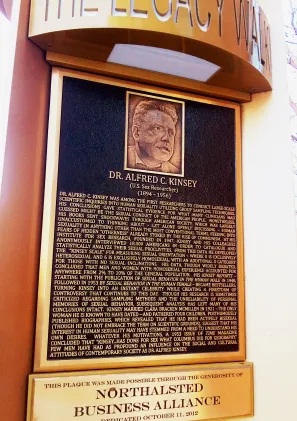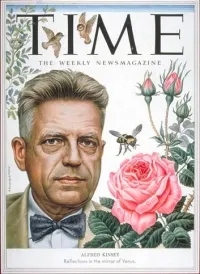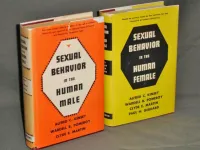Biography
1894 - 1956
"The only unnatural sex act is that which you cannot perform."
- Dr. Alfred Kinsey
Dr. Alfred C. Kinsey was among the first researchers to conduct large-scale scientific inquiries into human sexuality utilizing group sampling techniques. His conclusions gave statistical evidence for what many clinicians had guessed might be the sexual conduct of the American people. Nonetheless, his books sent shockwaves through American society, which was largely unaccustomed to thinking about – let alone openly discussing – human sexuality in anything other than the most conventional terms, feeding into fears of hidden “otherness” already stoked by the rise of Communism. At his Institute for Sex Research, founded in 1947, Kinsey and his colleagues anonymously interviewed 18,000 Americans in order to catalogue and statistically analyze their sexual proclivities. From this data he developed the “Kinsey Scale” for measuring sexual orientation – where 0 is exclusively heterosexual and 6 is exclusively homosexual, with an additional X category for those with no sexual inclinations. His data, though widely debated, concluded that men and women with homosexual experience accounted for anywhere from 2% to 10% of the general population. His Kinsey Reports – starting with the publication of Sexual Behavior in the Human Male in 1948, followed in 1953 by Sexual Behavior in the Human Female – became bestsellers, turning Kinsey into an instant celebrity while creating a firestorm of controversy that continues to this day. Though his research is sometimes criticized regarding sampling methods and the unreliability of personal memories of sexual behavior, subsequent analysis has left many of his conclusions intact. Kinsey married Clara Bracken McMillen in 1921 – the only woman he is known to have dated – and fathered four children. Posthumously published biographies, which revealed that he had been actively bisexual (though he did not embrace the term on scientific grounds), suggest that his interest in human sexuality may have stemmed from a need to understand his own desires. Whatever his motivations, a 1953 issue of TIME magazine concluded that “Kinsey...has done for sex what Columbus did for geography.” Few men have had as profound an influence on the social and cultural attitudes of contemporary society as Dr. Alfred Kinsey.
1894 - 1956
"The only unnatural sex act is that which you cannot perform."
- Dr. Alfred Kinsey
Dr. Alfred C. Kinsey was among the first researchers to conduct large-scale scientific inquiries into human sexuality utilizing group sampling techniques. His conclusions gave statistical evidence for what many clinicians had guessed might be the sexual conduct of the American people. Nonetheless, his books sent shockwaves through American society, which was largely unaccustomed to thinking about – let alone openly discussing – human sexuality in anything other than the most conventional terms, feeding into fears of hidden “otherness” already stoked by the rise of Communism. At his Institute for Sex Research, founded in 1947, Kinsey and his colleagues anonymously interviewed 18,000 Americans in order to catalogue and statistically analyze their sexual proclivities. From this data he developed the “Kinsey Scale” for measuring sexual orientation – where 0 is exclusively heterosexual and 6 is exclusively homosexual, with an additional X category for those with no sexual inclinations. His data, though widely debated, concluded that men and women with homosexual experience accounted for anywhere from 2% to 10% of the general population. His Kinsey Reports – starting with the publication of Sexual Behavior in the Human Male in 1948, followed in 1953 by Sexual Behavior in the Human Female – became bestsellers, turning Kinsey into an instant celebrity while creating a firestorm of controversy that continues to this day. Though his research is sometimes criticized regarding sampling methods and the unreliability of personal memories of sexual behavior, subsequent analysis has left many of his conclusions intact. Kinsey married Clara Bracken McMillen in 1921 – the only woman he is known to have dated – and fathered four children. Posthumously published biographies, which revealed that he had been actively bisexual (though he did not embrace the term on scientific grounds), suggest that his interest in human sexuality may have stemmed from a need to understand his own desires. Whatever his motivations, a 1953 issue of TIME magazine concluded that “Kinsey...has done for sex what Columbus did for geography.” Few men have had as profound an influence on the social and cultural attitudes of contemporary society as Dr. Alfred Kinsey.
Lesson Plan
Please login or register for an account to view this lesson plan.
Demography
Demography
Gender Male
Sexual Orientation Bisexual
Gender Identity Cisgender
Ethnicity Caucasian/White
Faith Construct Atheist
Nations Affiliated United States
Era/Epoch Homophile Movement (1945-1969)
Field(s) of Contribution
Academics
Author
Education
Journalism
Media & Communications
Medicine
Science
Social Sciences
STEM & Medicine
US History
Commemorations & Honors
National LGBTQ Wall of Honor at the Stonewall National Monument Inductee (2019)
Demography
Gender Male
Sexual Orientation Bisexual
Gender Identity Cisgender
Ethnicity Caucasian/White
Faith Construct Atheist
Nations Affiliated United States
Era/Epoch Homophile Movement (1945-1969)
Field(s) of Contribution
Academics
Author
Education
Journalism
Media & Communications
Medicine
Science
Social Sciences
STEM & Medicine
US History
Commemorations & Honors
National LGBTQ Wall of Honor at the Stonewall National Monument Inductee (2019)
Resources
Resources
Erickson, Julia A. Kiss and Tell: Surveying Sex in the Twentieth-Century. Cambridge, Mass.: Harvard University Press, 1999.
Gathorne-Hardy, Jonathan. Sex--The Measure of All Things: A Life of Alfred C. Kinsey Bloomington: Indiana University Press, 1998.
Jones, James H. Alfred C. Kinsey: A Public/Private Life. New York: Norton, 1997.
Kinsey, Alfred C., et al. Sexual Behavior in the Human Female. Philadelphia: W.B. Saunders, 1953.
Kinsey, Alfred C. Sexual Behavior in the Human Male. Philadelphia: W.B. Saunders, 1948.
https://kinseyinstitute.org/about/history/alfred-kinsey.php
https://www.ncbi.nlm.nih.gov/pmc/articles/PMC1447862/
https://www.biography.com/people/alfred-kinsey-9365493
https://www.lgbtqnation.com/2019/10/alfred-kinsey-armed-early-lgbtq-movement-research/
https://www.britannica.com/biography/Alfred-Charles-Kinsey
https://www.washingtonpost.com/wp-srv/style/longterm/books/chap1/alfredckinsey.htm
https://www.pbs.org/wgbh/americanexperience/features/kinsey-alfred-charles-kinsey/
Resources
Erickson, Julia A. Kiss and Tell: Surveying Sex in the Twentieth-Century. Cambridge, Mass.: Harvard University Press, 1999.
Gathorne-Hardy, Jonathan. Sex--The Measure of All Things: A Life of Alfred C. Kinsey Bloomington: Indiana University Press, 1998.
Jones, James H. Alfred C. Kinsey: A Public/Private Life. New York: Norton, 1997.
Kinsey, Alfred C., et al. Sexual Behavior in the Human Female. Philadelphia: W.B. Saunders, 1953.
Kinsey, Alfred C. Sexual Behavior in the Human Male. Philadelphia: W.B. Saunders, 1948.
https://kinseyinstitute.org/about/history/alfred-kinsey.php
https://www.ncbi.nlm.nih.gov/pmc/articles/PMC1447862/
https://www.biography.com/people/alfred-kinsey-9365493
https://www.lgbtqnation.com/2019/10/alfred-kinsey-armed-early-lgbtq-movement-research/
https://www.britannica.com/biography/Alfred-Charles-Kinsey
https://www.washingtonpost.com/wp-srv/style/longterm/books/chap1/alfredckinsey.htm
https://www.pbs.org/wgbh/americanexperience/features/kinsey-alfred-charles-kinsey/





